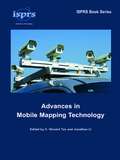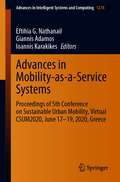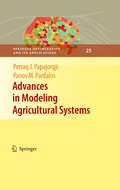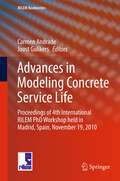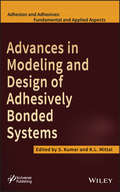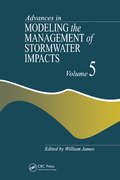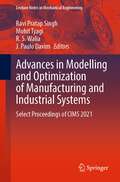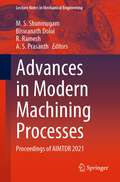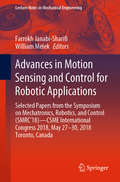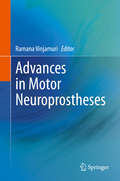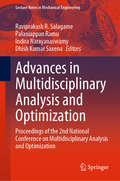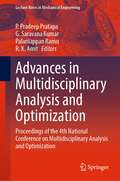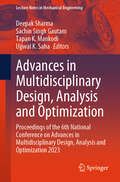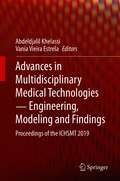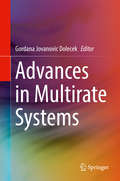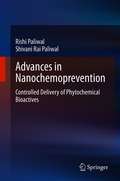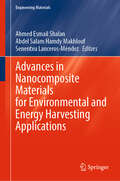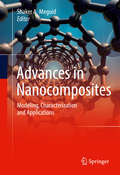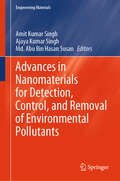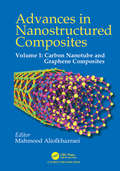- Table View
- List View
Advances in Mobile Mapping Technology (Isprs Book Ser. #4)
by Jonathan Li C. Vincent TaoThe growing market penetration of Internet mapping, satellite imaging and personal navigation has opened up great research and business opportunities to geospatial communities. Multi-platform and multi-sensor integrated mapping technology has clearly established a trend towards fast geospatial data acquisition. Sensors can be mounted on various pla
Advances in Mobility-as-a-Service Systems: Proceedings of 5th Conference on Sustainable Urban Mobility, Virtual CSUM2020, June 17-19, 2020, Greece (Advances in Intelligent Systems and Computing #1278)
by Eftihia G. Nathanail Giannis Adamos Ioannis KarakikesThis book gathers together innovative research and practical findings relating to urban mobility transformation. It is especially intended to provide academicians, researchers, practitioners and decision makers with effective strategies and techniques that can support urban mobility in a sustainable way. The chapters, which report on contributions presented at the 5th Conference on Sustainable Urban Mobility, held virtually on June 17-19, 2020, from Greece, cover the thematic areas of: social networks and traveler behavior; applications of technologies in transportation and big data analytics; transport infrastructure and traffic management; and transportation modeling and impact assessment. Special attention is given to public transport and demand responsive systems, electromobility, micromobility and automated vehicles. The book addresses the challenges of the near future, highlighting the importance of knowledge transfer, and it is intended to foster communication among universities, industries and public administration.
Advances in Modeling Agricultural Systems (Springer Optimization and Its Applications #25)
by Panos M. Pardalos Petraq PapajorgjiThis book presents an up-to-date review of advances in the mathematical modeling of agricultural systems. It covers a broad spectrum of problems and applications based on internet and communications technology, as well as methodological approaches based on the integration of different simulation and data management tools. Using real-world cases, each chapter presents a detailed solution of a problem in a particular field. This book demonstrates that regardless of the nature of the problem and the application domain, modeling is a central and important activity in the process of developing agricultural systems. Researchers and graduate students in the fields of agriculture and environmental studies will benefit from this book. It will also serve as an excellent reference for managers, team leaders, developers and modelers of agricultural and environmental systems and researchers in the applied computation field.
Advances in Modeling Concrete Service Life: Proceedings of 4th International RILEM PhD Workshop held in Madrid, Spain, November19, 2010 (RILEM Bookseries #3)
by Carmen Andrade Joost GulikersIn this book, a critical analysis is made on service life models related to reinforcement corrosion. The contributors are on the frontier of knowledge in the field of durability of reinforced concrete. Topics covered in the book include: causes and mechanisms of deterioration, transport mechanisms in concrete, numerical modeling of concrete behavior, durability modeling and prediction, reliability approach to structural design for durability, structural behavior following degradation of concrete structures, deterioration and repair of concrete structures, and corrosion measurement techniques.
Advances in Modeling and Design of Adhesively Bonded Systems
by K. L. Mittal S. KumarThe book comprehensively charts a way for industry to employ adhesively bonded joints to make systems more efficient and cost-effectiveAdhesively bonded systems have found applications in a wide spectrum of industries (e.g., aerospace, electronics, construction, ship building, biomedical, etc.) for a variety of purposes. Emerging adhesive materials with improved mechanical properties have allowed adhesion strength approaching that of the bonded materials themselves. Due to advances in adhesive materials and the many potential merits that adhesive bonding offers, adhesive bonding has replaced other joining methods in many applications.Containing nine articles written by world-renowned experts, the book deals with the advances in theoretical and computational modeling as well as the design and experimental aspects of adhesively bonded structural systems. Stress analysis and strength prediction of adhesively bonded structural systems, considering a range of material models under a variety of loading conditions, are discussed. Finite element modeling using macro-elements is elaborated on. Recent developments in modeling and experimental aspects of bonded systems with graded adhesive layers and dual adhesives are described. Simulation of progressive damage in bonded joints is addressed. A novel vibration-based approach to detect disbonding and delamination in composite joints is also discussed.ReadershipThe book is central to a range of engineers including mechanical, reliability, construction and surface engineers as well as materials scientists who are engaged in the mechanics of structural adhesive joints. Industries that will use this book include aerospace, electronics, biomedical, automotive, ship building, and construction.
Advances in Modeling the Management of Stormwater Impacts
by William JamesThe latest book in the popular series demonstrates state-of-the-art methods, models, and techniques for water quality management. This book includes a CD-ROM that collects hundreds of hard-to-find literature citations from the gray literature.
Advances in Modelling and Optimization of Manufacturing and Industrial Systems: Select Proceedings of CIMS 2021 (Lecture Notes in Mechanical Engineering)
by J. Paulo Davim Mohit Tyagi Ravi Pratap Singh R. S. WaliaThis book presents select proceedings of the 2nd International Conference on Industrial and Manufacturing Systems (CIMS 2021) and discusses the applications of soft computing, modelling and optimization practices in industrial and manufacturing systems. Various topics covered in this book include advanced machining methods and performances, industrial operations, processing with hybrid manufacturing techniques, fabrication and developments in micro-machining and its applications, practical issues in supply chain, micro-structure analysis, additive manufacturing processes, reliability and system analysis, material science and metallurgical behaviour analysis, product design and development, etc. The book will be a valuable reference for beginners, researchers, and professionals interested in the modelling, optimization and soft computing related aspects of industrial and production engineering and its allied domains.
Advances in Modern Machining Processes: Proceedings of AIMTDR 2021 (Lecture Notes in Mechanical Engineering)
by M. S. Shunmugam R. Ramesh Biswanath Doloi A. S. PrasanthThe book presents select proceedings of the 8th International and 29th All India Manufacturing Technology, Design and Research (AIMTDR 2021) conference. It covers recent advances in the realms of electro- physical and chemical machining, machining optimization, surface morphology and sustainable machining. The contents also include precision engineering, metrology and quality, automation and smart systems, enterprise manufacturing intelligence, among others. This book will evoke interest among academicians, researchers, and practicing engineers who aspire to comprehend advances pertaining to the domain of modern machining processes
Advances in Motion Sensing and Control for Robotic Applications: Selected Papers from the Symposium on Mechatronics, Robotics, and Control (SMRC’18)- CSME International Congress 2018, May 27-30, 2018 Toronto, Canada (Lecture Notes in Mechanical Engineering)
by William Melek Farrokh Janabi-SharifiThis book reports on advances in sensing, modeling and control methods for different robotic platforms such as multi-degree of freedom robotic arms, unmanned aerial vehicles and autonomous mobile platforms. Based on 2018 Symposium on Mechatronics, Robotics, and Control (SMTRC’18), held as part of the 2018 CSME International Congress, in York University, Toronto, Canada, the book covers a variety of topics, from filtering and state estimation to adaptive control of reconfigurable robots and more. Next-generation systems with advanced control, planning, perception and interaction capabilities will achieve functionalities far beyond today’s technology. Two key challenges remaining for advanced robot technologies are related to sensing and control in robotic systems. Advanced perception is needed to navigate changing environments. Adaptive and intelligent control systems must be developed to enable operation in unstructured and dynamic environments. The selected chapters in this book focus on both of the aforementioned areas and highlight the main trends and challenges in robot sensing and control. The first part of the book introduces chapters which focus on advanced perception and sensing for robotics applications. They include sensor filtering and state estimation for bipedal robots and motion capture systems analysis. The second part focuses on different modeling and control methods for robotic systems including flight control for UAVs, multi-variable robust control for modular and reconfigurable robotics and control for precision micromanipulation.
Advances in Motor Neuroprostheses
by Ramana VinjamuriThis book provides a comprehensive review of recent developments in the field of motor neuroprosthetics and brain-machine interfaces. Chapters in this book are provided by leading experts in the field and include topics such as the design and control of multidimensional prosthetics and exoskeletons, deep brain stimulation, functional electrical stimulation, deep learning for brain machine interfaces, biofeedback, and cognitive intent for adaptation of motor prostheses. This book is a great resource for undergraduate and graduate students, researchers, engineers from related disciplines, entrepreneurs, and anyone interested in the latest progress in the field of motor neuroprostheses.
Advances in Multidisciplinary Analysis and Optimization: Proceedings of the 2nd National Conference on Multidisciplinary Analysis and Optimization (Lecture Notes in Mechanical Engineering)
by Raviprakash R. Salagame Palaniappan Ramu Indira Narayanaswamy Dhish Kumar SaxenaThis volume contains select papers presented during the 2nd National Conference on Multidisciplinary Analysis and Optimization. It discusses new developments at the core of optimization methods and its application in multiple applications. The papers showcase fundamental problems and applications which include domains such as aerospace, automotive and industrial sectors. The variety of topics and diversity of insights presented in the general field of optimization and its use in design for different applications will be of interest to researchers in academia or industry.
Advances in Multidisciplinary Analysis and Optimization: Proceedings of the 4th National Conference on Multidisciplinary Analysis and Optimization (Lecture Notes in Mechanical Engineering)
by Palaniappan Ramu P. Pradeep Pratapa G. Saravana Kumar R. K. AmitThis volume contains select papers presented during the 4th National Conference on Multidisciplinary Analysis and Optimization. It discusses new developments at the core of optimization methods and their application in multiple applications. The papers showcase fundamental problems and applications which include domains such as aerospace, automotive and industrial sectors. The variety of topics and diversity of insights presented in the general field of optimization and its use in design for different applications will be of interest to researchers in academia or industry.
Advances in Multidisciplinary Design, Analysis and Optimization: Proceedings of the 6th National Conference on Advances in Multidisciplinary Design, Analysis and Optimization 2023 (Lecture Notes in Mechanical Engineering)
by Deepak Sharma Sachin Singh Gautam Tapan K. Mankodi Ujjwal K. SahaThis book contains select papers presented during the 6th National Conference on Multidisciplinary Analysis and Optimization. The book focuses on design and analysis as applicable to optimization of engineering systems in aerospace, mechanical, automotive, manufacturing, biomedical, and other domains. The book includes papers on the topics such as metamodeling or surrogate modeling, systems design and optimization, optimization and additive manufacturing, mixed integer and linear programming, multiscale and multiphysics problems, among others. The book can be a valuable reference for researchers and professionals interested in the field of optimization and its use in design for different applications.
Advances in Multidisciplinary Medical Technologies ─ Engineering, Modeling and Findings: Proceedings of the ICHSMT 2019
by Vania Vieira Estrela Abdeldjalil KhelassiThis book collects the proceedings of the International Congress on Health Sciences and Medical Technologies (ICHSMT), held in Tlemcen, Algeria, from December 5 to 7, 2019. The proceedings present a forum for the latest projects and research in scientific and technological development with an emphasis on smart healthcare system design and future technologies. ICHSMT brings together researchers, students, and professionals from the healthcare, corporate, and academic sectors. It includes a far-reaching program supported by a variety of technical tracks that seek to promote medical technologies and innovation at a nationwide level.
Advances in Multirate Systems
by Gordana Jovanovic DolecekThis book offers readers a single-source reference to the implementation aspects of multirate systems, advances in design of comb decimation filters and multirate filter banks. The authors describe a variety of the most recent applications in fields such as, image and video processing, digital communications, software and cognitive radio.
Advances in Nano-Photonics and Quantum Optics: Proceedings of PHOTONICS 2023, Volume 4 (Lecture Notes in Electrical Engineering #1245)
by Tapajyoti Das Gupta Manukumara Manjappa C. M. Chandrashekar Ambarish GhoshThis book presents the proceedings of the Biennial Photonics Conference (Photonics 2023) held at IISc, Bengaluru on 5-8 July 2023. It covers topics across multiple areas of photonics, including established areas like optical communication and networks, quantum optics, non-linear and ultrafast photonics, nanophotonics, biophotonics and bioimaging, photonic integrated circuits, fibers and sensors, optical materials and fabrication techniques, optical metrology, and instrumentation, optofluidics, laser applications, optoelectronics. The book also covers emerging areas in photonics, such as THz photonics, structured Light, 2D materials, optomechanics, topological photonics, and AI/ML in photonics. The book will be useful for researchers and professionals interested in the broad field of photonics.
Advances in Nanochemoprevention: Controlled Delivery of Phytochemical Bioactives
by Rishi Paliwal Shivani Rai PaliwalThis book discusses the recent progress and advances in nanochemoprevention. Chemoprevention utilizes natural dietary compounds and has regained interest due to larger safety window and proven efficacy of such molecules in cancer treatments. Nanotechnology has revolutionized drug delivery through passive as well as active targeting. This book provides a comprehensive overview of phytochemical bioactives that are used in chemoprevention. It gives a comprehensive overview of the variety of natural molecules and types of nanoparticles as well as mechanistic aspects of their superior efficacy over plain drug molecules. The book concludes with summarizing the progress of pre-clinical results of developed formulations for cancer treatment using nano-chemoprevention.
Advances in Nanocomposite Materials for Environmental and Energy Harvesting Applications (Engineering Materials)
by Abdel Salam Hamdy Makhlouf Senentxu Lanceros-Méndez Ahmed Esmail ShalanThis book discusses the fundamental, synthesis, properties, physico-chemical characterizations and applications of recently explored nanocomposite materials. It covers the applications of these different nanocomposite materials in the environmental and energy harvesting fields. The chapters explore the different techniques used for preparation and characterization of several types of nanocomposite materials for applications related to environmental and energy pathways. This book presents a panorama of current research in the field of nanocomposite structures for different applications. It also assesses the advantages and disadvantages of using different types of nanocomposite in the design of different material products. The comprehensive chapters explain the interactions between nanocomposite materials and mechanisms related to applications in environmental pollution and energy shortage.
Advances in Nanocomposites: Modeling, Characterization and Applications
by Shaker A. MeguidThis book introduces nanocomposite materials possessing a broad range of multifunctionality. It elucidates novel and highly original developments from recent research and development of these critical, new engineered materials. The collection examines multiscale modeling, molecular dynamics, atomistic based continuum, synthesis and characterization, condition health monitoring, spectroscopic characterization techniques, self-lubricating materials, and conducting polymers. The volume features the latest efforts of some of the most eminent researchers in the world. Providing a range of perspectives from the laboratory and the field, Advances in Nanocomposites: Modeling and Characterization is ideal for engineers, physicists, and materials scientists in academia and industry.
Advances in Nanomaterials for Detection, Control, and Removal of Environmental Pollutants (Engineering Materials)
by Amit Kumar Singh Ajaya Kumar Singh Md. Abu Bin Hasan SusanThis book presents a comprehensive exploration of the latest research in nanomaterial development for environmental pollution control. It delves into various themes, including the utilization of nanosensors in environmental monitoring, the creation of nano adsorbents and nanocatalysts for pollutant removal and degradation, and the potential application of nanomaterials and nanotechnology in remediating contaminated sites. The book also addresses potential risks associated with using nanomaterials in environmental pollution control, discussing nanotoxicology and the potential environmental and health impacts of nanomaterials. Furthermore, it explores the existing regulatory framework for nanomaterial usage in environmental pollution control and outlines future directions for developing and implementing nanomaterials in this domain. Featuring collected contributions from an international cross-section of active researchers in this broad and interdisciplinary field, this book caters to scientists, researchers, students, and professionals in environmental science, chemistry, materials science, and nanotechnology. It provides a detailed overview of recent advancements in nanomaterial development and application for environmental pollution control, emphasizing how nanotechnology holds promise for delivering effective solutions to environmental challenges.
Advances in Nanomaterials-based Cell Biology Research
by Yunfeng Lin Ronghui ZhouThis book aims to comprehensively summarize the current research status of nanomaterials and cell biology. It highlights the biological effects and biomedical applications of nanomaterials for specific diseases, bone tissue engineering, and skeletal muscle regeneration. It also provides the details of the biomedical applications of nucleic acid nanomaterials in drug delivery carriers, antimicrobial therapy, vaccine, and neurodegenerative diseases. Therefore, this book renders the audience a better understanding of nanomaterials along with the diverse applications in the cell biology field from recent works to perspectives.
Advances in Nanomaterials: Applications (Advanced Structured Materials #79)
by Mushahid Husain Zishan Husain KhanThis book provides a review of the latest research findings and key applications in the field of nanomaterials. The book contains twelve chapters on different aspects of nanomaterials. It begins with key fundamental concepts to aid readers new to the discipline of nanomaterials, and then moves to the different types of nanomaterials studied. The book includes chapters based on the applications of nanomaterials for nano-biotechnology and solar energy. Overall, the book comprises chapters on a variety of topics on nanomaterials from expert authors across the globe. This book will appeal to researchers and professional alike, and may also be used as a reference for courses in nanomaterials.
Advances in Nanomaterials: Fundamentals, Properties and Applications
by Ganesh BalasubramanianThis exploratory textbook starts with fundamentals that satisfy the needs of a diverse group of educators, researchers and students aspiring to engage in research and engineering of nanomaterials. It bridges the gap between undergraduate students in science and engineering who have not yet chosen a specific career path, graduate students still considering different disciplines and the cross-cutting scientific topics in nanomaterials. It extends to methods of common practice in the field, spanning experimental, and theoretical techniques. The extensive use of nanomaterials, such as carbon nanotubes, in the future of global technological solutions underscores the relevance of this text aimed at students and researchers with a range of interests. "Advances in Nanomaterials: Fundamentals, Properties and Applications," is ideal for senior undergraduate and graduate students, faculty and general science enthusiasts interested in nanomaterials across contexts ranging from solar energy, structural engineering, to medical devices, to semiconductors.
Advances in Nanostructured Cellulose-based Biomaterials (SpringerBriefs in Applied Sciences and Technology)
by Neftali L. V. Carreño Ananda M. Barbosa Bruno S. Noremberg Mabel M. S. Salas Susana C. M. Fernandes Jalel LabidiThis book provides an overview of the advances on nanostructured celullose from different obtaining forms: natural plants and bacterial microorganisms. It gives the reader an introduction of cellulose focusing in nanosize particles, its potential applications and future perspectives. The potential use of cellulose in the biomedical field is highlighted.
Advances in Nanostructured Composites: Volume 1: Carbon Nanotube and Graphene Composites
by Mahmood AliofkhazraeiComposites and nanocomposites are used in cases where long durability and strength of components are required; i.e., where high stress levels, erosion processes and multiphase environments are present, including the parts under collision and impact, the parts under rotating motion and erosion (like excavation drills in oil and gas wells). The first volume of this book aims to provide a guide for fabrication of new nanocomposites mainly based on carbon nanotubes and graphene. The main topics of this volume are: Application of Nano-powders for Formation of Metal Matrix of Composites, Conjugated Polymer Nanocomposites, Biopolymer Nanocomposites, Dental Nanocomposites, Graphene-based Nanocomposites for Electrochemical Energy Storage, Polymer/Filler Composites for Optical Diffuse Reflectors, Synthesis and Applications of LDH-Based Nanocomposites, Rubber—CNT Nanocomposites, Nanocomposite Fibers with Carbon Nanotubes, Fabrications of Graphene Based Nanocomposites for Electrochemical Sensing of Drug Molecules, Recent Advances in Graphene Metal Oxide Based Nanocomposites.
